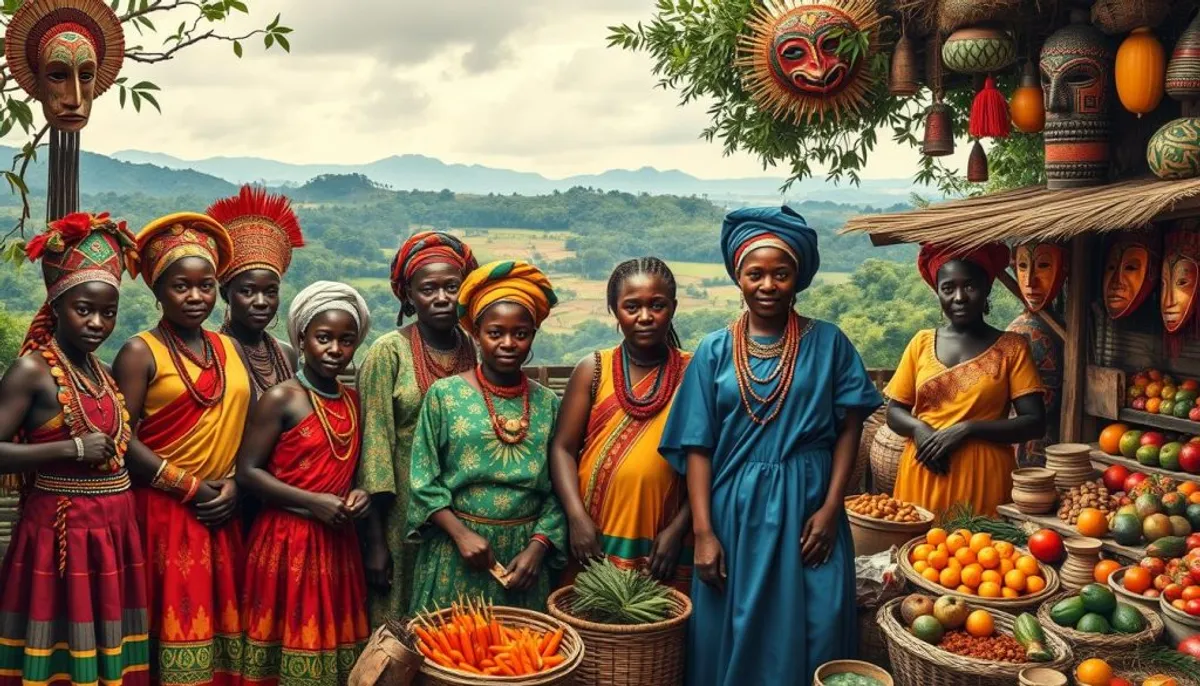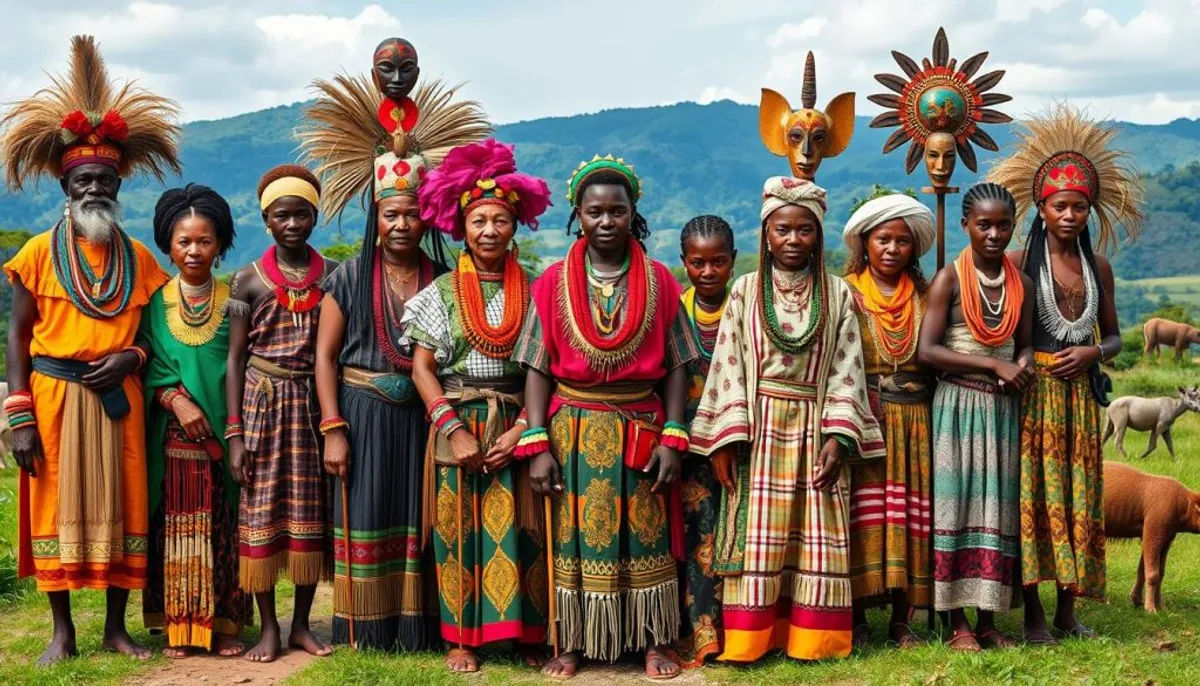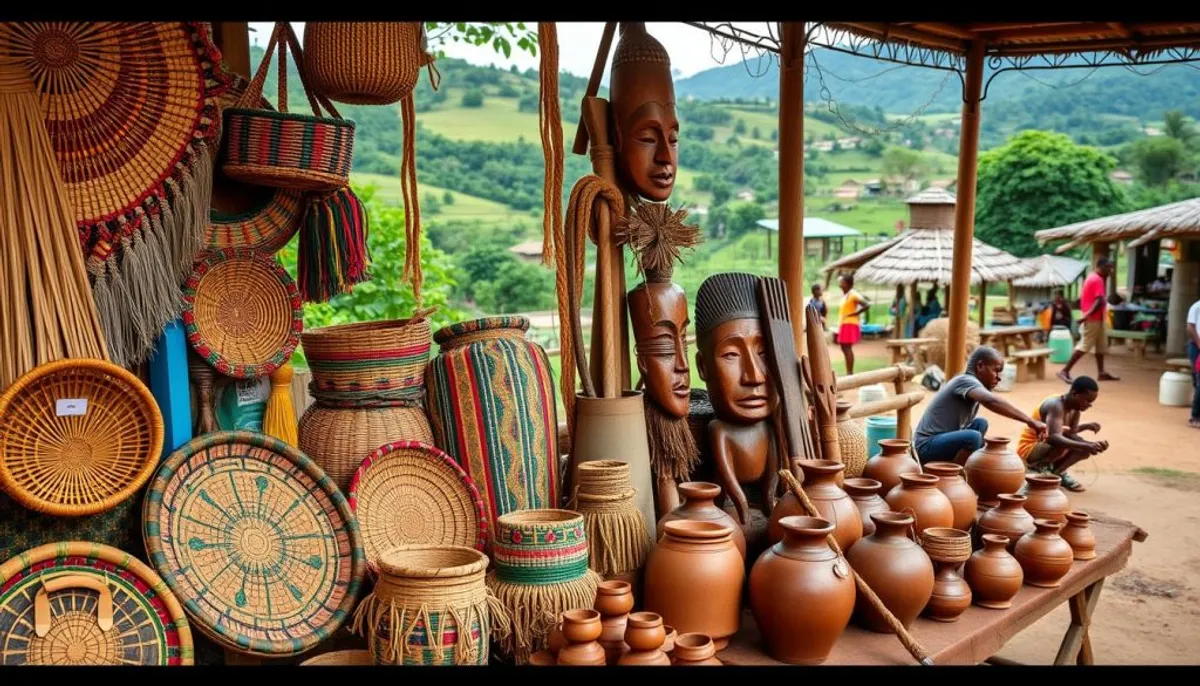Cameroon presents itself as a true cultural mosaic, housing an unparalleled ethnic richness. With over 250 ethnic groups and just as many languages, it embodies cultural diversity at its peak. Its population, estimated at 24 million inhabitants in 2017, reflects a range of Cameroonian traditions.
The official bilingualism, a colonial legacy, allows for the coexistence of French and English. Francophones, representing 70% of the population, are spread across eight regions. Anglophones, on the other hand, make up 30% of the population, primarily in the Northwest and Southwest. This linguistic duality enriches the cultural landscape of the country.

Cultural diversity is also manifested in beliefs. Christianity dominates with 65-69% of followers, followed by Islam (20-30%) and traditional African religions (5-19%). This religious plurality shapes cultural practices and influences the daily lives of Cameroonians.
Cameroon is divided into four major cultural areas: the Fang-Beti zone, the Soudano-Sahelian zone, the coastal zone, and the Grassland. Each region contributes its unique input to Cameroonian traditions, from gastronomy to the arts, including local governance systems.
The ethnic and linguistic diversity of Cameroon
Cameroon stands out for its exceptional cultural and linguistic richness. With over 250 ethnic groups, this Central African country offers a fascinating panorama of traditions and languages. This cultural diversity is a major asset for the country's development.
An ethnic mosaic
Cameroon is home to remarkable ethnic diversity. It includes pygmies, Bantus, Sudanese, and Arab-Berbers, each contributing their unique input to the cultural tapestry of the country. This diversity is reflected in artisanal practices, particularly developed in the West and North of the country.
Bilingualism in Cameroon
Bilingualism in Cameroon is a distinctive feature. French and English are the official languages, used in administration and education. In 2021, 59% of the population spoke French and 41% English. This linguistic duality is evident in the media: 69% of radio broadcasts are in French and 31% in English.
Camfranglais: a linguistic innovation
Camfranglais, a creative mix of French, English, and local languages, has become popular, especially among urban youth. This linguistic innovation reflects the adaptability and creativity of Cameroonians in the face of their rich cultural heritage.
The linguistic diversity of Cameroon goes beyond official bilingualism. The country boasts over 260 national languages, including 60 Chamito-Semitic languages, 2 Nilo-Saharan languages, and 215 Niger-Congo languages. This linguistic wealth is a major asset for the development of ecotourism in the various ecosystems of the country.
What are the cultures of Cameroon
Cameroon presents itself as a true cultural mosaic, home to over 200 ethnic groups and 280 indigenous languages. This richness is manifested through the traditions, music, cuisine, and art of each region. The cultural diversity of the country is fascinating.
The Bamiléké traditions
The Bamiléké, originating from the west of Cameroon, are distinguished by their traditional chiefdoms. Their funeral ceremonies, called "funérailles," are major events lasting several days. Their art is characterized by colorful masks and wooden sculptures.
The Sawa culture
The Sawa culture, present on the Atlantic coast, is famous for the Ngondo festival. This annual event brings together coastal peoples to celebrate their maritime heritage. The traditional Sawa dances, such as Assiko, are recognized for their rhythmic and energetic movements.
The Grassfields heritage
The Grassfields region, located in the northwest, is known for its exceptional craftsmanship. Artisans from the Grassfields excel in wood carving, mask making, and the creation of traditional fabrics. Their music, particularly the Mangambeu, is essential to their cultural identity, just like the local belfort cuisine that reflects the traditions and flavors of this region.
The Grand Nord traditions
The Grand Nord of Cameroon is influenced by Islamic and nomadic culture. Festivals like the Lebouo highlight the pastoral traditions of the region. Music and dance play a crucial role in preserving the cultural identity of the peoples of the Grand Nord.
| Region | Notable Traditions | Art and Craftsmanship | Music and Dance |
|---|---|---|---|
| Bamiléké | Chiefdoms, funerals | Masks, sculptures | Bend skin |
| Sawa | Ngondo Festival | Maritime art | Assiko |
| Grassfields | Craftsmanship | Carving, weaving | Mangambeu |
| Grand Nord | Lebouo Festival | Nomadic craftsmanship | Pastoral music |

Traditional governance systems
Cameroon is rich in diversity of traditional governance systems. Chiefdoms and kingdoms play an essential role in social and cultural life. They coexist with modern administration, creating a unique blend of traditions and modernity.
In the North and West, traditional chiefdoms are very influential. The chiefs, surrounded by notable figures, exercise their authority according to established hierarchies. However, the evolution of Cameroonian society has brought changes to these systems.
Education and urbanization have challenged the authority of chiefs. A study in Foumban and Yaoundé shows tensions between tradition and political modernity. The youth, being more educated, sometimes contest traditional power.
| Evolution Factors | Impact on Chiefdoms |
|---|---|
| Education | Questioning of authority |
| Urbanization | Weakening of community ties |
| Citizen participation | Tensions with traditional power |
Despite the challenges, chiefdoms remain crucial for social cohesion. They help preserve cultural identity in the face of social changes. Their future depends on their ability to adapt while maintaining their cultural essence.
Artistic and cultural expressions
Cameroon stands out for its artistic and cultural diversity. With its 20 million inhabitants, it presents a range of creative expressions. These reflect its rich and varied heritage.
Traditional and modern music
Cameroonian music is characterized by an unprecedented blend of traditions and modernity. Reniss, for example, has captivated an international audience. He has managed to combine ancestral rhythms with contemporary sounds, while fitting into a digital culture in full evolution. On his part, Franko, Maahlox, and Mr. Leo have shone beyond national borders, thanks to their urban music.
Ritual and festive dances
Traditional dances in Cameroon play an essential role in the culture of the country. They are present during rituals and celebrations, thus transmitting oral history. Koffi Kôkô, for example, has integrated these ancestral movements into contemporary works. He thus contributes to the preservation of this living heritage.
Craftsmanship and visual arts
Cameroonian craftsmanship stands out for its sculptures, fabrics, and decorative objects. Visual arts thrive, with artists like Samuel Fosso. He draws inspiration from clothing traditions to create symbolic works. These creations illustrate the cultural richness of Cameroon, which has over 300 languages.

| Artistic Form | Characteristics | Representative Artists |
|---|---|---|
| Music | Fusion of traditions and modernity | Reniss, Franko, Maahlox |
| Dance | Ritual and contemporary | Koffi Kôkô, Salia Sanou |
| Visual Arts | Inspired by local traditions | Samuel Fosso |
Culinary and gastronomic practices
Cameroonian cuisine is a true treasure of flavors and traditions. It reflects the cultural diversity of the country with its 280 ethnic groups. This culinary richness is explained by the history of Cameroon, its varied climate, and its multiple regional influences.
Iconic dishes
There are many and varied traditional dishes in Cameroon. Ndolé, a specialty of the Littoral region, is a must-try. Chicken DG and grilled fish are beloved classics throughout the country. In the West, kondre and njapche are enjoyed. The North is distinguished by n’domba and lalo. These dishes highlight local products such as cassava, yam, and peanuts.
Traditional beverages
Local drinks perfectly complement Cameroonian dishes. Palm wine, extracted from the palm tree, is very popular. There are also craft beers brewed from local grains. These drinks often accompany meals and celebrations.
Food rituals
In Cameroon, meals are much more than a simple necessity. They are an opportunity to share and strengthen social bonds. Some dishes are associated with traditional ceremonies. For example, koki is often prepared for weddings. Family or friend meals are special moments to pass down culinary traditions from one generation to the next.
The Cameroonian cuisine, rich in traditional dishes and culinary rituals, is a true art of living. It offers a unique tasting experience, reflecting the cultural diversity of the country.
Cultural festivals and celebrations
Cameroon is animated by its festivals, jewels of culture. These events reflect the diversity and richness of the country. The NGONDO, a celebration of coastal peoples, takes place from November to December in Douala. It celebrates Sawa traditions and attracts thousands of visitors.
In the west, the NGUON festival of the Bamoun and the MEDUMBA in Bangangté occur every two years. They offer a spectacle of dances and ancestral rituals. The NYEM NYEM in Adamaoua and the Mayi in Kribi illustrate the variety of Cameroonian festivities. These celebrations help preserve and transmit local customs.
Festivals are not limited to big cities. Events like Chepan in Bamendjou and Gah’chou in Batchingou enliven the villages of the west. The arts and culture festival Bangou KEBOUH POUANIEUP in April-May and the Taro festival in Bamendjinda in November allow for the discovery of local traditions. These celebrations strengthen cultural identity and encourage tourism in Cameroon.
RelatedRelated articles


